 Image search results - "kagura" Image search results - "kagura" |

April 8, 2006 at Ushigome-Tansu Kumin Hall in Kagurazaka, TokyoStarting at 4 pm, this was the third and last show of the day and all 400 seats were sold out.
The performance had two parts separated by a 20-min. intermission. Each part had several different dances.
|
|

"Hana no Kai" Dance by Kagurazaka geishaThe "Hana no Kai" geisha dance is held annually by geisha in Kagurazaka, one of Tokyo's major geisha districts. "Hana" means livley or gaudy. And "Kai" can mean gathering or party.
They held two shows on the same day. This was the second show starting at 3 pm on April 16, 2005. It lasted till about 4:45 pm.
|
|

Part 1 - Edo Scenes (江戸風情): 1. Fuji Murasaki (Purple Wisteria) 藤むらさきDancers: 小奴、千佳、由良子、舞子
|
|

"Blue Ocean Waves" (青海波)They performed four numbers. This first one was called "Blue Ocean Waves" performed by five geisha.
|
|

1. Fuji Murasaki (Purple Wisteria)
|
|

Notice that the kimono design shows waves.
|
|

1. Fuji Murasaki (Purple Wisteria)
|
|
|

1. Fuji Murasaki (Purple Wisteria)
|
|

Rear view
|
|

1. Fuji Murasaki (Purple Wisteria)
|
|

Shimada hairstyleStandard hairstyle for geisha. This a wig.
|
|

1. Fuji Murasaki (Purple Wisteria) by Kagurazaka geisha
|
|

Music and singing accompanimentAll numbers was accompanied by live music and singing.
|
|

1. Fuji Murasaki (Purple Wisteria)
|
|
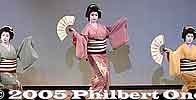
Eight Views of Tatsumi (巽八景)The second number was about the Tatsumi and Monzen-nakacho (Fukagawa) district in Koto Ward, Tokyo. The dance reflects the chic and bravado of the area (in the old days) which was one of Tokyo's gay quarters with geisha as well.
|
|

1. Fuji Murasaki (Purple Wisteria)
|
|
|

1. Fuji Murasaki (Purple Wisteria)
|
|
|

1. Fuji Murasaki (Purple Wisteria)
|
|
|

1. Fuji Murasaki (Purple Wisteria)Dancer's name is Maiko 舞子
|
|

Her big round eyes makes her look like a real doll.
|
|

Unlike geisha dances in Kyoto which have elaborate backgrounds, the background here is quite plain, making us focus on the geisha which were enough eye candy. The background really didn't matter. The dances were very aesthetic and pleasing to the eyes and ears.
|
|

1. Fuji Murasaki (Purple Wisteria)
|
|
|

1. Fuji Murasaki (Purple Wisteria)
|
|
|
|

Edo Scenes: 2. Sumidagawa (Sumida River)Solo dancer: 眞由美 (Mayumi)
|
|
|

2. Sumidagawa (Sumida River)
|
|

Closing curtain
|
|

2. Sumidagawa (Sumida River)
|
|

IntermissionThis Ushigome-Tansu Kumin Hall can hold almost 400 people. Both shows were sold out. Tickets are sold about a month in advance. They sold out within 2 weeks. I was sitting in the middle of the hall (non-reserved seating). Tickets cost only 2,000 yen.
|
|

Edo Scenes: 3. Edo no Nigiwai (Liveliness of Edo) 江戸の賑わいDancers: 竜也、英子、万り
|
|

Chestnut Rice Cakes (栗餅)The third number was called "Chestnut Mochi." Mochi is rice cake. They pound sticky rice to make it. Performed by two geisha. The one in blue is a male role.
|
|

3. Edo no Nigiwai (Liveliness of Edo)
|
|
|
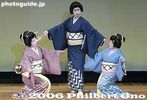
3. Edo no Nigiwai (Liveliness of Edo)
|
|

The cherry blossoms lining Sotobori Moat also look stunning from the road, Sotobori-dori in front of Kagurazaka.
|
|

Lively Colors of Kagurazaka(神楽坂華の彩)The final number, called Lively Colors of Kagurazaka (Kagurazaka Hana no Irodori) actually consisted of seven dances. This was the first one performed by three geisha. (ひと里)
|
|

3. Edo no Nigiwai (Liveliness of Edo)After this dance was a 20-min. intermission.
|
|

Kagurazaka geisha dance
|
|

Part 2 - 浴曲三味線草: 1. Kagurazakari 神楽ざかり
|
|

Kagurazaka geisha dance
|
|

1. Kagurazakari 神楽ざかり
|
|
|

1. Kagurazakari 神楽ざかり
|
|

引けや引け引け
|
|

1. Kagurazakari 神楽ざかり
|
|
|

Singers and musicians
|
|

Mt. Fuji and Mt. Asama(富士や浅間). Solo dance by a geisha named Mari(万り).
|
|

1. Kagurazakari 神楽ざかり
|
|

2. Hitozato ひと里
|
|

The Word Called Love (恋と云う字)
|
|

2. Hitozato ひと里
|
|
|

3. 梅にも春 Ume ni mo HaruDancers: 千丸、史織
|
|
|
|

3. 梅にも春 Ume nimo Haru
|
|
|

3. 梅にも春 Ume nimo HaruOffering a drink of sake.
|
|

4. Sakura Kazashite 桜かざしてDancers: 舞子、万り (Maiko and Mari)
|
|

Finale
|
|

4. Sakura Kazashite 桜かざしてDancer 舞子 (Maiko)
|
|
|

5. Otsu-e 大津絵眞由美 (Mayumi)
|
|
|

5. Otsu-e 大津絵眞由美
|
|

6. Hahha Kudoki ハッハくどき
|
|
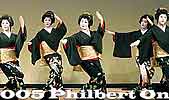
Finale
|
|
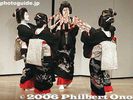
6. Hahha Kudoki ハッハくどき
|
|

Praying at BishamonBishamon is a Buddhist temple in Kagurazaka where the geisha go to worship. The song included a reference to this temple.
|
|

6. Hahha Kudoki ハッハくどき
|
|

Praying at Bishamon
|
|
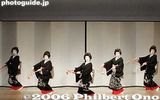
6. Hahha Kudoki ハッハくどき
|
|

FinaleEveryone performed in the finale.
|
|

6. Hahha Kudoki ハッハくどき
|
|
|
|

6. Hahha Kudoki ハッハくどき
|
|
|

7. Sawagi さわぎThe finale where all the geisha appear on stage.
|
|

Towel throwingDuring the finale, the geisha started throwing hand towels to the audience.
|
|

7. Sawagi さわぎ
|
|

Towel throwingThere were women in the middle the hall also throwing towels to people sitting further back.
|
|

7. Sawagi さわぎ
|
|
|
|

7. Sawagi さわぎ
|
|

A bow of thanks
|
|

Tossing free hand towels to the audience, a real crowd pleaser...They do this every year. Most people sitting in the front can catch one.
|
|

Closing wordsThe women standing in the back are the okami-san (proprietress) of high-class Japanese-style restaurants in Kagurazaka where the geisha are hired to perform at private geisha parties.
|
|
|
|

Arigato
|
|

Hand clappingThis is called sanbon-jime, a series of hand clapping to mark the end of a successful meeting.
|
|

Facing the right in thanks...
|
|

Hall entrance and sign
|
|

(Applause)
|
|

Geisha catching a taxi homePhoto by Kevin Mihaly.
|
|

With okami-san
|
|

As the climax of the 37th Kagurazaka Matsuri Festival, the Kagurazaka Awa Odori Dance was held on July 25-26, 2008, from 7 pm to 9 pm. These photos were taken on July 25, 2008. Crowd at Bishamonten.
|
|

The Awa Odori is held on Kagurazaka's main street called Kagurazaka-dori, a sloping road near Iidabashi Station. 神楽坂阿波踊り
|
|

Eighteen awa odori dance troupes danced this night.
|
|

These dancers head to the starting point.
|
|

The starting point was here, at the foot of the sloping Kagurazaka-dori near Iidabashi Station.
|
|
|

The local Kagurazaka Awa Odori troupe is Kagura-ren. かぐら連
|
|

Kagura-ren かぐら連
|
|

Kagura-ren かぐら連
|
|
|

Kagura-ren かぐら連
|
|

Kagura-ren かぐら連
|
|

Unusual to see a woman drumming a big taiko drum.
|
|

Flute players
|
|

The Kagura-ren dancers proceed up the sloping Kagurazaka-dori.
|
|
|
|
|
|
|

Kagurazaka Awa Odori Dance 神楽坂阿波踊り
|
|
|
|
|
|

Kagurazaka Awa Odori Dance 神楽坂阿波踊り
|
|

だむだん連
|
|

Damudan-ren has an easily-recognizable kimono design pattern. だむだん連
|
|
|
|
|

I always see this guy at Awa Odori in Tokyo.
|
|

Hyottoko-ren
|
|
|
|

Kagurazaka Awa Odori Dance
|
|
|
|
|
|

The street is not so crowded for the most part.
|
|
|
|
|
|
|
|

Crowd interaction.
|
|

Would you believe a Daikon-ren? Yes, eating it is good for your body. だいこん連
|
|
|
|

Kagurazaka Awa Odori dancers
|
|
|
|
|

The street was most crowded in front of Bishamonten temple, the focal point of Kagurazaka.
|
|
|
|
|

Kaguazaka Awa Odori dancers in front of Bishamonten temple. 毘沙門天
|
|
|
|
|
|

Kagurazaka Matsuri poster
|
|
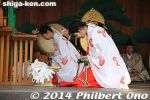
I was waiting for this. Sacred dances by shrine maidens who looked to be high school girls.
|
|

In the morning and early afternoon of January 1 and 2, shrine maidens perform sacred dances (初神楽) on the Noh stage.
|
|
|
|
|
|
|
|
|
|
|
|
|
|
|
|
|
|
|
|
|
|
|
|
|

Kaguraden stage where they performed sacred dances. They would dance on Jan. 1 and 2, in the morning and early afternoon.
|
|

Most of the snow had melted.
|
|

Amazake (sweet sake, non-alcoholic) for 300 yen/cup to warm you up.
|
|
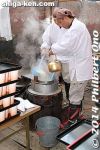
Preparing gallons upon gallons of amazake (sweet sake, non-alcoholic). 300 yen/cup.
|
|
|
|
|
|